How long can you survive if you run out of air?

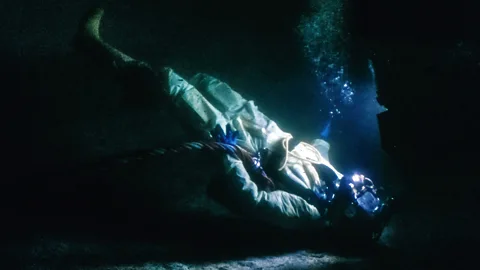 Dogwoof
DogwoofScience tells us the human body can only survive for a few minutes without oxygen. But some people are defying this accepted truth.
There was a sickening crack when the thick cable connecting Chris Lemons to the ship above him snapped. This vital umbilical cord to the world above carried power, communications, heat and air to his diving suit 100m (328ft) below the surface of the sea.
While his colleagues the terrible noise of this lifeline breaking, Lemons himself heard nothing. One moment he was jammed against the metal underwater structure they had been working on and then he was tumbling backwards towards the ocean floor. His link to the ship above was gone, along with any hope of finding his way back to it.
Most crucially, his air supply had also vanished, leaving him with just six or seven minutes of emergency air supply. Over the next 30 minutes at the bottom of the North Sea, Lemons would experience something that few people have lived to talk about: he ran out of air.
You might also like:
“I’m not sure I had a full handle on what was happening,” recalls Lemons. “I hit the sea bed on my back and was surrounded by an all-encoming darkness. I knew I had a very small amount of gas on my back and my chances of getting out of it were almost non-existent. A kind of resignation came over me. I being taken over by grief in some ways.”
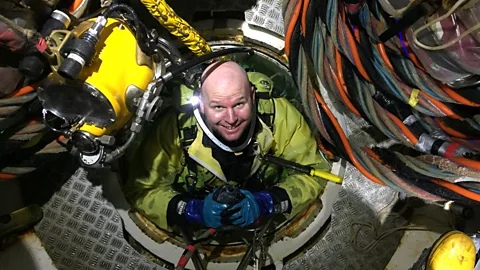 Chris Lemons
Chris LemonsLemons had been part of a saturation dive team fixing piping on an oil well manifold at the Huntington Oil Field, around 127miles (204km) east of Aberdeen on the east coast of Scotland. To do this work, divers must spend a month living, sleeping and eating in specially constructed chambers on board the dive ship, separated from the rest of the crew by a sheet of metal and glass. In these 6m-long tubes, the three divers acclimatise to the pressures they will experience once underwater.
It is an unusual form of isolation. The three divers can talk to and see their crewmates outside the chamber, but they are otherwise cut off from them. The of each team are entirely reliant upon one another – it takes six days of decompression before they can leave this hyperbaric chamber or help can get inside.
“It is a very strange situation,” says 39-year-old Lemons. “You are living on the ship surrounded by lots of people who are just a sheath of metal away, but you are completely isolated from them.
“It is quicker to get back from the Moon than it is from the depths of the sea in some ways.” (Read some of the oddest facts about the Apollo missions to the Moon.)
Decompression is necessary because nitrogen gas from the air divers breathe while underwater dissolves into their blood stream and tissues when they are at depth. As they come to the surface, the pressure of the surrounding water is lifted and the nitrogen bubbles out. If this happens too quickly, it can cause painful tissue and nerve damage and even lead to death if the bubbles form in the brain – a condition commonly known as “the bends”.
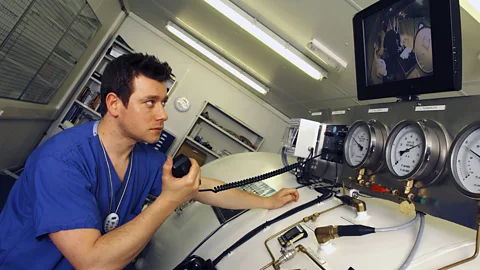 Getty
GettyThe divers who do this work, however, take the risks in their stride. For Lemons, he was most concerned about spending such a long time away from his fiancée Morag Martin and the home they shared on the west coast of Scotland.
The day of 18 September 2012 had started normally enough for Lemons and the two colleagues he was diving with – Dave Youasa and Duncan Allcock. The three climbed into the diving bell, which would be lowered from the ship, the Bibby Topaz, to the sea bed where they would carry out their repair work.
“In many ways, it was just an ordinary day at the office,” says Lemons. While not as experienced as the other two men, he had been a diver for eight years and had been saturation diving for a year and a half, taking part in nine deep-water dives. “The sea was a little rough on the surface, but it was pretty clear underwater.”
 Dogwoof
DogwoofThat rough sea, however, would trigger a chain of events that almost claimed Lemons’s life. Normally dive vessels use computer-controlled navigation and propulsion systems – known as dynamic positioning – to keep them over the dive site while they have people in the water.
As Lemons and Youasa began repairing the piping underwater, with Allcock supervising them from the bell, the Bibby Topaz’s dynamic positioning system suddenly failed. The ship rapidly began drifting off course.
On the sea floor, alarms sounded on the divers’ communications system. Lemons and Youasa were instructed to get back to the bell. But as they began following their umbilical cords, the ship had already drifted back over the tall metal structure they had been working on, meaning they had to climb over it.
When they neared the top, however, Lemons’s umbilical became snagged on a piece of metal sticking out of the structure. Before he could free it, the drifting ship pulled it tight, dragging him into the metal beams.
“Dave realised something was wrong and turned to come back to me,” says Lemons, whose story has been turned into a feature length documentary Last Breath. “We had this strange moment where we were looking into each other’s eyes. He was desperately flailing to get to me, but the boat was pulling him away. Before I knew it, I didn’t have any gas because the cable was stretched so tight.”
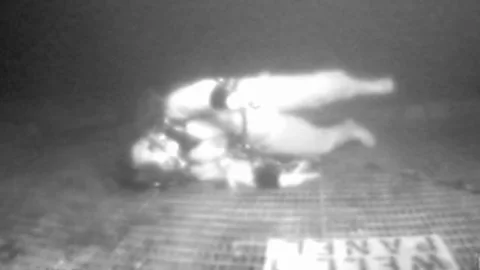 Floating Harbour
Floating HarbourThe strain on the cable must have been immense. Composed of a tangle of hoses and electrical wires with a rope running through the middle, it creaked as the drifting boat pulled it tighter and tighter. Lemons instinctively turned the knob on his helmet to start the flow of gas from the emergency tank on his back. But before he could do anything else, the cable snapped, sending him tumbling back to the sea bed.
Miraculously, in the pitch darkness, Lemons managed to pull himself upright and feel his way back to the well structure, climbing it again to the top in the hope of seeing the bell and getting back to safety.
“When I got there, the bell was nowhere to be seen,” says Lemons. “I took a measured decision to calm down and conserve what little gas I had left. I only had about six to seven minutes of emergency gas on my back. I didn’t expect to be rescued, so I just curled up into a ball.”
Without oxygen, the human body can only survive for a few minutes before the biological processes that power its cells begin to fail. The electrical signals that power the neurons in the brain decrease and eventually stop altogether.
“Loss of oxygen is right at the very sharp end of survival,” says Mike Tipton, head of the extreme environments laboratory at Portsmouth University in the UK. “The human body doesn’t have a great store of oxygen – maybe a couple of litres. How you use that up depends on your metabolic rate.”
 Dogwoof
DogwoofAn adult at rest will typically use between a fifth and a quarter of a litre of oxygen every minute. This can rise to four litres every minute if they are exercising hard.
“If someone is stressed or panicked, then this can raise their metabolic rate too,” adds Tipton, who has studied people who have survived for long periods without air underwater.
Back on board the Bibby Topaz, the crew desperately tried to manually navigate back into position to save their lost colleague. As they drifted further away, they launched a remote-controlled submarine in the hope of finding him.
When it did, they watched helplessly on its cameras as Lemons’s movements gradually stopped, his life fading away.
“I can pulling the last bits of air from the tank on my back,” says Lemons. “It takes more effort to suck the gas down. It felt a bit like the moments before you fall asleep. It wasn’t unpleasant, but I can feeling angry and apologising a lot to my fiancée Morag. I was angry about the damage this was going to do to other people. Then there was nothing.” (Learn what it would be like if we all knew when we might die.)
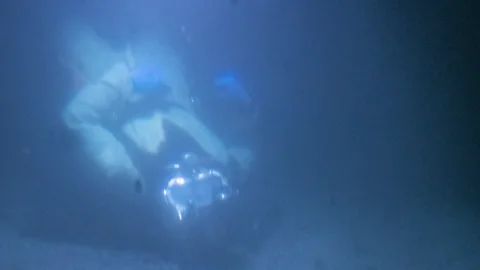 Dogwoof
DogwoofIt took around 30 minutes before the crew of the Bibby Topaz were able to regain control and restart the failed dynamic positioning system. When Youasa reached Lemons on top of the underwater structure, his body was still.
Through sheer will, Youasa dragged his fallen colleague back to the bell and ed him up to Allcock. When they removed his helmet, Lemons was blue and not breathing. Instinctively, Allcock gave him two breaths of mouth to mouth resuscitation.
Miraculously, Lemons gasped back into consciousness.
“I felt very groggy and there were some flashing lights, but I don’t have many lucid memories of waking up,” says Lemons. “I recall Dave sitting crumbled on the other side of the bell looking exhausted and not really knowing why. It was only a few days later that I realised the gravity of the situation.”
Nearly seven years later, Lemons is still perplexed as to how he managed to survive for so long without oxygen. Common sense suggests he should have perished after so long at the bottom of the sea.
But it seems likely the cold water of the North Sea may have played a role –around 100m (328ft) down, the water was probably below 3C (37F). Without the hot water flowing through the umbilical cord to heat his suit, his body and brain will have quickly cooled.
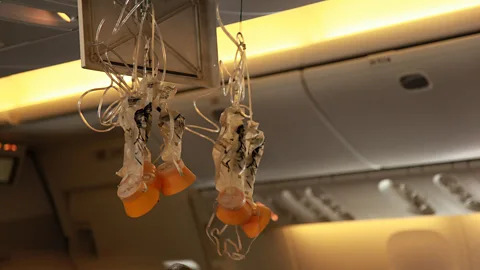 Alamy
Alamy“Rapid cooling of the brain can increase survival time without oxygen,” says Tipton. “If you reduce the temperature by 10 degrees the metabolic rate drops by a half to a third. If you lower the brain temperature down to 30C (86F), it can increase the survival time from 10 to 20 minutes. If you cool the brain to 20C (68F), you can get an hour.”
The pressurised gas that saturation divers usually breathe may have given Lemons an additional chance. When breathing high levels of oxygen under pressure, it can dissolve into the blood stream, giving the body additional reserves to draw on.
Going hypoxic
Divers are perhaps the most likely people to experience a sudden loss of their air supply. But there are many other situations where the oxygen supply can be cut off. Firefighters often rely on breathing equipment when entering smoke-choked buildings, while high-altitude fighter jet pilots also use breathing masks.
At the less extreme end, a lack of oxygen – known as hypoxia – can affect many other people. Mountain climbers experience low levels of oxygen when they are on high mountains, a condition which often has been blamed for accidents. When levels of oxygen drop, brain function can suffer, leading to poor decisions and confusion.
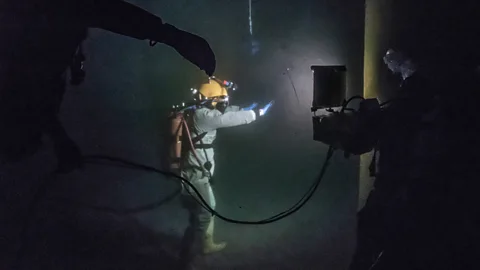 Dogwoof
DogwoofPatients undergoing surgery will also often undergo mild hypoxia, which is thought to impact their recovery. Strokes are also caused by a patient’s brain being starved of oxygen, leading to cell death and damage that can have lasting effects on their lives.
“There are a lot of diseases where the final stage is hypoxia,” says Tipton. “One of the things that happens is that people who are hypoxic start to lose their peripheral vision and they end up looking at a point. It is thought to be the reason why people report seeing a light at the end of the tunnel in near death experiences.”
Lemons himself survived his time without oxygen unscathed. He found only a couple of bruises on his legs after his ordeal.
But his survival is not unheard of either. Tipton has examined 43 separate cases in the medical literature of people who have been submerged in water for long periods. Four of these recovered, including a two-and-a-half-year-old girl who survived being under water for at least 66 minutes.
“Children and women are more likely to survive because they are smaller and their bodies tend to cool much faster,” says Tipton.
 Alamy
AlamyThe training of saturation divers like Lemons may also be inadvertently teaching their bodies to cope with extreme situations. Researchers at the Norwegian University of Science and Technology (NTNU) in Trondheim have found that saturation divers adapt to the extreme environment they work in by altering the genetic activity of their blood cells.
“We saw a marked change in the genetic programs for oxygen transport,” says Ingrid Eftedal, head of the barophysiology research group at NTNU. Oxygen is carried around our bodies in haemoglobin, a molecule found in our red blood cells. “We found the activity of genes at all levels of oxygen transport – from haemoglobin to the production and activity of red blood cells is turned down during saturation diving,” Eftedal adds.
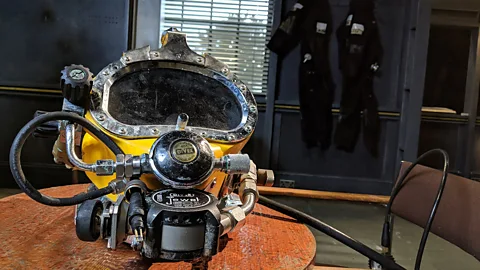 Dogwoof
DogwoofShe and her colleagues believe this might be a response to the high concentrations of oxygen they breathe while underwater. It is possible that the slow-down of oxygen transport in Lemons’s body allowed it to make the meagre supplies it had last longer.
Exercising before diving has also been shown to help reduce the risk of developing the bends.
Studies of indigenous people who habitually free dive without additional air have also shown just how much the human body can adapt to life without oxygen. The Bajau people in Indonesia can reach depths of up to 70m (230ft) while holding their breath as they hunt for food with spears.
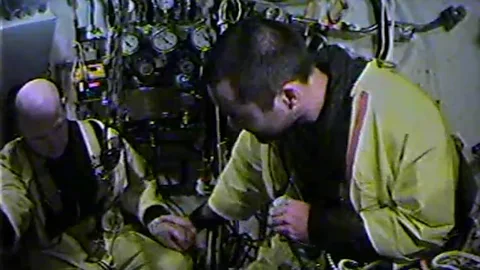 Floating Harbour
Floating HarbourMelissa Ilardo, an evolutionary geneticist at the University of Utah, has found that the Bajau have genetically evolved to have spleens that are 50% larger than the their land-dwelling neighbours, the Saluan.
The spleen is thought to play a key role in enabling humans to free dive.
“There is something called the mammalian dive reflex, which in humans is triggered by the combination of holding your breath and submerging yourself in water,” says Ilardo. “One of the effects of the dive reflex is contraction of the spleen. The spleen acts as a reservoir for oxygen-rich red blood cells, and when it contracts these red blood cells are pushed into circulation, providing an oxygen boost. It can be thought of as a biological scuba tank.”
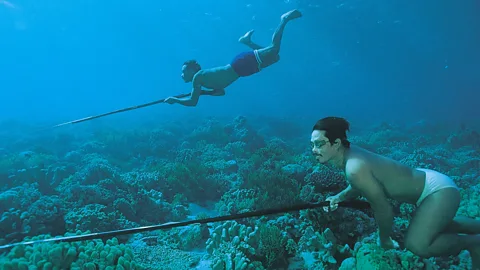 Alamy
AlamyWith larger spleens, it is thought the Bajau benefit from a greater injection of oxygenated blood and so can hold their breath for longer. One Bajau diver that Ilardo met told her he had spent 13 minutes underwater.
Lemons himself returned to diving about three weeks after his accident – at the very spot where it had happened, to finish the job they had started. He has also married Morag and they have a daughter together.
Reflecting on his brush with death and his miraculous survival, he doesn’t take much credit for his own actions.
“One of the greatest reasons I survived was the quality of the people around me,” he says. “In truth, I did very little. It was the professionalism and the heroics of the two in the water with me and everyone on the ship. I was very lucky.”
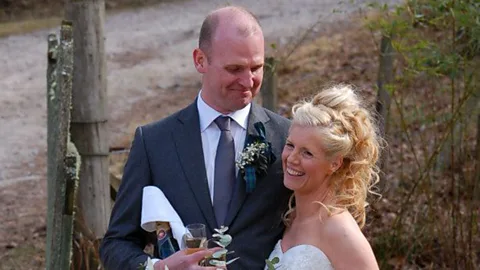 Chris Lemons
Chris LemonsHis accident has triggered a number of changes in the diving community. They now use emergency tanks that carry 40 minutes of air rather than five. The umbilical cords are now festooned with fairy lights so they can be seen more easily under water.
The changes in his own life have not been so dramatic.
“I’ve still got to change the nappies,” he jokes. But he does find himself thinking about death differently. “I don’t see it as something to be feared any more. It is more about what you leave behind.”
* Last Breath will be shown on BBC Scotland on 7 May 2019 at 10pm and will be available in the UK online. It is available on Netflix elsewhere in the world.
Worst Case Scenario
This article is part of a BBC Future column called Worst Case Scenario, which looks at the extremes of the human experience and the remarkable resilience people display in the face of adversity.
It aims to look at ways people have coped when the worst happens and what lessons we can learn from their experiences.
--
If you liked this story, sign up for the weekly bbc.com features newsletter, called “If You Only Read 6 Things This Week”. A handpicked selection of stories from BBC Future, Culture, Worklife, and Travel, delivered to your inbox every Friday.
